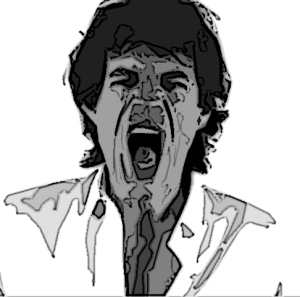THE UGLY SEX FACE and Singer's "Facial Posture"
The term “Facial ‘Posture’” and most references to the mimic muscles are FROUGHT with potential misunderstanding for the student. For this reason it’s extraordinarily important that the student goes out of each and every lesson with a clear understanding of what secondary resonance is, what primary resonance is and what the primary production of the Vocalis is. If this distinction is not acoustically and sensorily clear, students (and some professionals as well) will tend to over-regulate and manipulate primary functions through secondary facial muscular movements!
These helping tensions actually ‘help’, otherwise we wouldn’t use them. The problem is that when they’re overused and/or misunderstood, they become solutions to vocal problems which themselves become the problems. This is not to say that the correspondences between the facial muscles and vocal tract tuning are not useful. It is to say that we must be clear about what and where the primary sources of our tone actually are.
I’ll explain in more detail for those out there who love anatomy and function. The vocal tract is the primary strengthener of the partials. These, however, are FELT more strongly (as a rule) in the frontal, maxillary and sphenoid sinuses, along with an entire series of facial muscles (zygomaticus major and minor, levator labii, buccinators, risorius, procerus and epicranium). There is another important distinction here.
FIRST, these muscles, sinuses and bone structures receive and conduct resonance. Resonance CAN be regulated by the muscle tone and positioning of the structures. SECOND, these structures belong to functional and bio-energetic muscle ‘chains’ which CAN regulate important inner structures of the vocal tract itself. Levator Labii, to use just one example, belongs to a chain through the raphe mandibularis which indirectly regulates the tensor and levator palatini and the subtle adjustment of the hamulus pterigoideus of the sphenoid bone, upon which the soft palate is hung. In other words, muscle tone of the muscle which raises and tones the upper lip indirectly affects the height, depth and breadth of the soft palate, giving us what the bel canto school called cupola, or that ‘dome’ feeling of the soft palate. To use another example, the risorius, an internal muscle of the middle cheek, when brought into balanced tone, exerts a pull which rounds the constrictor medialis, or the middle swallowing muscle in the back of the vocal tract. I’ve heard this referred to as “Tubare la Voce”, by some of my more ‘bel canto’ oriented teachers. The proper calibration of this muscle chain with pitch, strengthens enormously the second and singers formant. Students describe the feeling of this resonance as ‘addictive’. It feels effortless, efficient and LONGS for repeatability.
Just how often singers over-regulate these muscles is clear if you’ve ever done photo-portraiture from the wings during a performance. Still pictures of soloists WHILE they are singing often look mask-like and even grotesque. The best time to photograph a singer during a performance, I’ve found, is while they’re taking a preparatory breath or while they’re listening to another singer singing. That said, it’s fascinating to study still pictures of yourself in the act of singing. It makes the balance and the exaggeration of facial helping tensions very clear.
I remember having lunch with my sister and a bunch of her sexy friends. It was always an advantage for me to have a sister with a lot of sexy friends, because if I managed to not talk long enough (not always easy, I admit), I could actually fade into the background, listen carefully and really learn a lot about women. In this case I actually managed it and they started talking about some new, young, sex-symbol singer they’d heard. They began swooning about what a gorgeous voice this young singer had and how good-looking he was. Then one of them said; “yeah, I know what you mean, except when he sings loud high notes. Then he gets the ‘ugly sex face’!” Without exception all of them made noises like eeew, uuch, iiii, eeeeh, right…..’the ugly sex face’.
Now no one has ever said you need to look picture perfect ALL the time while singing. Singing is not a visual art form! However, it’s instructive to learn when you’re exaggerating these tensions to the point of grotesqueness and ugliness. Not because someone might consider it ugly, as secondarily important as visual impressions in singing are, but rather because overtaxing the vocal system day in and day out is unhealthy for the instrument. When your eyes bulge, your sterno-cleido-mastoid muscle is in maximum tension, the veins in your forehead are out, your jaw is fixed and you’re turning shades of crimson, you may begin to consider the fact that you are perhaps producing a slight excess of sub-glottal pressure when singing. Volume is a function of optimum acoustic space in the primary resonator, NOT a function of excess pressure.
An understanding of this distinction prevents students from using their facial muscles in overly rigid ways. The optimal regulation of the muscles of the face allows us as singers to not only conduct the resonance flow, but to intuitively arrange our vocal tract tuning to the acoustical vowel. The facial muscles producing a piano tone in the upper middle range have a different ‘feel’ than the facial muscles producing a FF in the extreme upper range. PLUS, each of us and each of our students have different shape vocal tracts, different shape facial muscles and different shape cranial bones. So optimization looks different from singer to singer. As if that weren’t enough, WE change over time as well. A slight head cold in the middle of winter, with slightly swollen secondary skin and fluid flow within and over the tissues will feel and behave differently than slightly dry vocal tract tissue in a desert climate in the summer. The more flexibly we understand how our structures function, the more optimally we can use our instruments!
Evan Bortnick Wiesbaden

